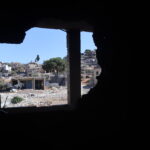Days after Pakistan’s Feb. 8 general election, the Election Commission of Pakistan released the official results confirming a major political upset. Contrary to what most political pundits and observers had predicted, independents aligned with former Prime Minister Imran Khan’s Pakistan Tehreek-e-Insaf (PTI) won the most seats at the national level, followed by former Prime Minister Nawaz Sharif’s Pakistan Muslim League-Nawaz (PML-N), the Pakistan Peoples Party (PPP) and the Muttahida Qaumi Movement (MQM). No party won an absolute majority needed to form a government on its own. The resultant uncertainty means the United States may have to contend with a government that is more focused on navigating internal politics and less so on addressing strategic challenges.
The election results — the PTI won 93 of 266 contestable seats at the national level, the PML-N 75 seats, the PPP 54 seats and MQM 17 seats — are accompanied by significant controversy and uncertainty on Pakistan’s political future. On the one hand, the most likely scenario appears to be a coalition government that may struggle to muster the political strength to push through much-needed economic reforms and take on serious governance and security challenges. On the other hand, several contenders have raised allegations of vote tampering that will call into question the credibility of a future government. PTI-aligned candidates in particular claim that the delays in the final announcement of results are evidence of irregularities. Even before the election, it was clear that the electoral playing field was being tilted against the PTI. The US State Department has noted allegations of interference in the electoral process and called for a full investigation. In its preliminary report, Pakistan’s polling watchdog, Free and Fair Election Network, noted that there was transparency at the polling stations, but it was compromised at the vote counting and tabulation stage.
Despite not winning the most seats, the PML-N is now trying to cobble together a coalition government with the PPP and MQM — as these parties together have a near majority of seats, which is required to form a government. It has also nominated former Prime Minister Shehbaz Sharif — Nawaz Sharif’s brother — to lead the coalition as the new prime minister. For its part, the PTI has announced an intent to form a government at the center as well as in the provinces of Punjab and Khyber Pakhtunkhwa, but it is unclear who it will ally with to get the majority required to form a government. It is more likely that PTI-aligned candidates will sit in the opposition in the national assembly, as the party has made clear it will not ally with either the PML-N or PPP.
The Verdict of the People
The victory of PTI-backed candidates defies the expectations of political pundits in Pakistan. It was widely anticipated that the PML-N would win and the PTI would lose the election. At the heart of this projection was the state of the relationship between Khan and Pakistan’s powerful military establishment, which was seen to be backing the PML-N’s return to power and blocking Khan and his PTI.
Khan fell out with the military when his government was deposed in a vote of no confidence in 2022, which he charged was a regime-change operation orchestrated by the military with the United States. His party has been in the line of fire since May 9, 2023, when its supporters attacked military establishments across the country. Khan himself has been in prison since last year due to several cases charging him with graft and improper handling of classified information, which meant he was unable to campaign for his party in the election. Perhaps most significantly, leading up to the election, the PTI was also denied its election symbol (a cricket bat) by the Pakistani Supreme Court, which was widely seen as part of a broader campaign to tilt the electoral playing field against the party.
The fact that despite all these measures, PTI-backed candidates won such a large share is a remarkable outcome, making the 2024 election one of the most significant elections in contemporary Pakistani history. One way to read the vote is that the Pakistani people have rejected the two traditional, dynastic parties — the PML-N and PPP — and embraced Khan’s aspirational, populist political platform. Another way to read the outcome is that it is also a rejection of the military establishment’s role in politics, in particular its opposition to the PTI and the clampdown against the party since last year.
The results also point to Pakistanis’ discontent with the country’s overall trajectory and the electoral process being a solution to the challenges facing the country. According to Gallup, Pakistanis are deeply pessimistic about the country’s economic future and they also question the fairness of the electoral process — before the election, seven in 10 Pakistanis said they lacked confidence in the honesty of the elections.
What Happens Next?
Much remains uncertain about government formation — it appears more likely that the PML-N will form a coalition government with the PPP and the MQM. Khan announced from prison that the PTI would not join with either the PML-N or PPP to form a government. The PTI will likely form a provincial government in Khyber Pakhtunkhwa where it swept nearly all provincial seats. It may also try to form a provincial government in Punjab but will face stiff resistance from the PML-N. Given that PTI candidates ran as independents, the party will face pressure of its winning candidates being poached by rivals, especially the PML-N.
Even if the PML-N and the PPP are able to form a coalition government in Islamabad, the PTI will be positioned to disrupt its functioning, perhaps through street protests, court cases challenging the electoral results and inside the parliament with its sizable representation. The military establishment may try to contain any PTI agitation and enable the coalition government to get down to the business of governing. The hybrid approach of the coalition and the military establishment working together can nominally work, but it is structurally unstable, as it lacks a popular mandate, doesn’t have clarity on responsibility and risks disagreements between the coalition government and the establishment.
It remains to be seen if the military establishment can find a political solution to limit the deep anger of the PTI’s large base of support. A narrow path to a modicum of stability that the army might be inclined to take is backing a PML-N-led coalition supported by the PPP to enter into negotiations with the International Monetary Fund (IMF) while also conceding space to the PTI — including potentially through the future release of Khan — to contain protests against the new political order. In the best case, there will be economic stability and a reduction in the political temperature. To be sure, continued political wrangling and machinations will dominate the near term.
Pakistan’s Economic Challenges
Pakistan is also at an economic crossroads. In the last six months, due to a short-term IMF bailout package which is set to end in March, Pakistan has found some fragile economic stability. Preserving this stability after the end of the program requires urgent steps toward a new IMF program. Such a program is necessary for Pakistan to manage $25-$30 billion of annual external debt obligations. To that end, the new government must negotiate a large multiyear IMF program. This will require the government to commit to a path of fiscal discipline, unpopular tax reforms, privatization of state-owned businesses and withdrawal of energy subsidies, while also obtaining support from the United States, China, and Gulf powers at the IMF.
Negotiating such a program will be challenging for a coalition government led by the PML-N’s Shehbaz Sharif as prime minister. Not only will it have to forge consensus within the coalition on difficult policy adjustments required by the IMF, it may also have to do so amid a strong protest by the PTI. If the PML-N takes the lead on economic policy, it will have to address a serious credibility gap due to stalling by its former finance minister, Ishaq Dar, on the IMF’s reform prescriptions in late 2022 and the first half of 2023. Those concerns could be amplified by the dynamics of a coalition. Still Shehbaz Sharif has the experience of closing a deal with the IMF, which he did in June 2023 as prime minister by personally negotiating with the IMF Managing Director Kristalina Georgieva and sidelining Dar. In the off chance that the PTI can form a government, it too will evoke similar concerns; the party has also resisted economic reform in the past and of late not offered any clear position on the economy. Khan also remains ambivalent on approaching the IMF.
In any scenario, timing is critical to preserve the hard-earned gains of the last six months. A delay in the formation of a government will make the transition to a new IMF program more challenging. But the swift formation of a government that appoints a technically competent and empowered finance minister will encourage the IMF and Pakistan’s partners to move quickly to provide the assistance Pakistan needs to keep its economy stable.
Implications for US Policy
The United States, and in fact many countries interested in Pakistan’s stability, had hoped that the general elections would be an inflection point that would allow Pakistan to move beyond the all-consuming political crisis since the no-confidence vote against Khan in April 2022. Unfortunately, rather than resolving the crisis, the election has created more uncertainty in Pakistan, and the credibility crisis facing the incoming government can further polarize Pakistani society. Ideally, the incoming government should be focused on the twin crises of the economy and security that Pakistan confronts, but it is unclear if it will have the policy space or political attention to forcefully tackle these challenges.
The developing situation in Pakistan will compel US policymakers to be cautious on engagement with the new government. They will also have to calibrate a response that speaks to the domestic political tumult and democratic backsliding in a way that doesn’t exacerbate the political and economic crisis and further destabilize the country. Finally, they will have to contend with the consequences for US security interests in a region of a military leadership roiled in greater controversy. Policymakers should be prepared that when a government is formed, they will be engaging with a political and military leadership that will have the precarious domestic political situation at the top of its mind rather than being focused on strategic challenges, including counterterrorism, India policy, strategic stability, and the intensifying US-China strategic competition.
This article was originally published by the United States Institute of Peace.














